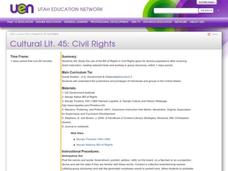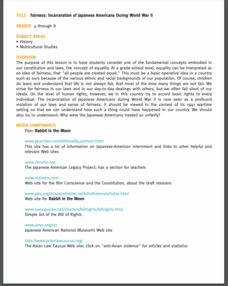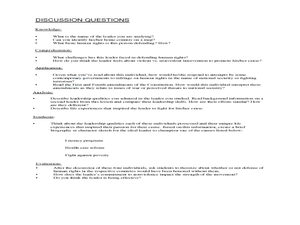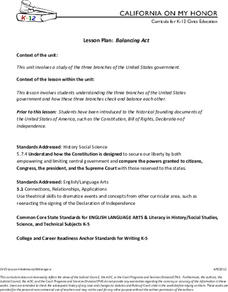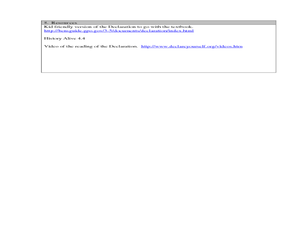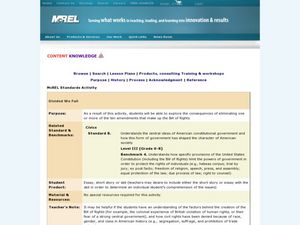Library of Virginia
An Overview of American Slavery
The final lesson in a unit study of American slavery asks young historians to synthesize what they have learned about how slavery in America changed over time. Revisiting the many documents they have examined, they consider the economic,...
Curated OER
Constitutional Resources
Pupils explore the REpublican Era and the writing of the constitution and Billof Rights through various links and activities included in this collection.
Curated OER
Civil Rights
Students are introduced to the concept of Civil Rights. In groups, they use a timeline of the Navajo tribe to identify the ways the tribe has made advances in Civil Rights throughout the years. To end the lesson, they take notes and...
Curated OER
The Constitution of the United States
Students explore the Web site provided to answer questions about The Constitution of the United States. They write the missing word of words in the blanks. Students use this Scavenger Hunt to help familiarize themselves with the...
Curated OER
Are We Free Yet?
Students read excerpts from several Freedom Documents, evaluate amount of freedom guaranteed by each document, and rank documents on scale to determine which grant greatest and least amount of personal freedom.
Curated OER
A More Perfect Union
Fourth graders complete a unit of lessons on the development of the U.S. government. They examine the main ideas of the Declaration of Independence, develop a class translation of the preamble to the Constitution, create a flow chart,...
Curated OER
The Glorious Revolution, the American Revolution, and the French Revolution
Students relate the Glorious Revolution, the American Revolution, and the French Revolution through web based research and scenarios.
Curated OER
Fairness: Incarceration of Japanese Americans During World War II
Young scholars examine fairness in relation to the incarceration of Japanese Americans during WWII. In this equality instructional activity, students watch a video "Rabbit in the Moon" and discuss what happened to the Japanese Americans...
Curated OER
Who’s Got Rights? An Introduction to Human Rights and Human Rights Defenders
High schoolers explore human rights issues. In this social justice instructional activity, students examine human rights as they read segments of the "Universal Declaration of Human Rights," discuss photographs with human rights...
Curated OER
Significance of Individuals to Defending Human Rights
Eleventh graders examine four different kinds of human rights. In this American Government lesson, 11th graders research the assigned human right in their groups. Students create a presentation about this human right to their classmates.
Curated OER
Justice in America
Eleventh graders analyze primary sources for evidence of intent and purpose. In this American government lesson, 11th graders compose a one-page response explaining their understanding of "justice." Students read and examine quotes about...
Curated OER
Rights and Responsibilities
Students focus on the rights and responsibilities of being an American citizen as they develop a T-chart and discuss the topic.
Curated OER
Journey to Topaz, a Literature Based Approach
Students view a video clip of the experiences of Japanese-Americans during World War II. They read parts of a book in which a child tells her story about living in the internment camps. They participate in a simulation activity as well.
Teaching Tolerance
Understanding the Prison Label
Break the chain. An engaging lesson examines why it is so hard to break free of the prison system in the US. Academics participate in a reader's theater, read primary sources, and discuss their thoughts. The lesson explains the hardships...
Teaching Tolerance
Parallels Between Mass Incarceration and Jim Crow
Is history repeating itself? A riveting lesson examines the parallels between mass incarceration in the U.S. and the Jim Crow Laws of the past. Academics review Jim Crow Laws and compare them to mass incarcerations of African Americans....
Judicial Branch of California
Balancing Act: The Three Branches
What do hula hoops and the American system of government have in common? Using hands-on station activities, pupils consider the roles of the three branches of government. A script for teachers and writing prompts help round out a...
National Endowment for the Humanities
A Day for the Constitution
The "Constitution Day and Citizenship Day" law requires schools receiving any federal funding to provide educational programming on the history of the American Constitution. The lesson plans, materials, videos, questions, and activities...
Curated OER
Social Darwinism and American Laissez-faire Capitalism
Students investigate Social Darwinism. In this government systems instructional activity, students listen to their instructor present a lecture on the details of Social Darwinism and American laissez-faire capitalism. Students respond to...
Curated OER
Political and Cultural Road to the American Revolution
Learners examine the Declaration of Independence. For this Revolutionary War instructional activity, young scholars use primary sources to analyze how the creation of the Declaration of Independence lead to the development of the United...
Curated OER
U.s. Constitution Roll Call Test
Students act as newspaper reporters from 1787 and interview some of the signers of the Constitution. They study the contributions of these Founding Fathers: Washington, Franklin, Madison, Hamilton and discuss the purpose of the U.S....
Curated OER
Divided We Fall
Students investigate the consequences of eliminating one or more of the amendments to the Bill of Rights.
Curated OER
Constitutional Resources
Students explore the Constitution, bill of rights, framers, Supreme court cases and educational games.
Curated OER
Building Awareness of the Japanese American Wartime Experience
Pupils research the Japanese American World War II Camp Experience. They discuss the experience in the context of civil rights and the Bill of Rights.
Curated OER
With Liberty and Justice for All
Fifth graders identify and define in their own words the first ten amendments to the Constitution. They are assigned a CDV or amendment from the Bill of Rights and create and present a one-minute skit demonstrating it.




